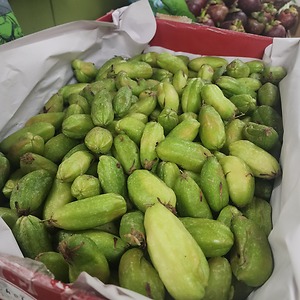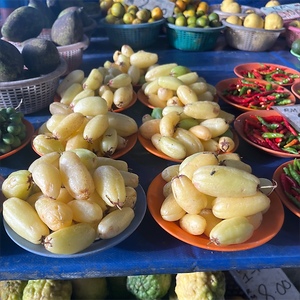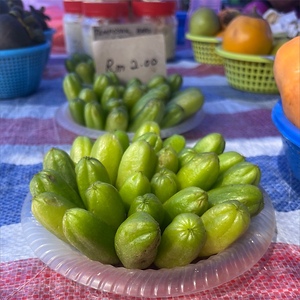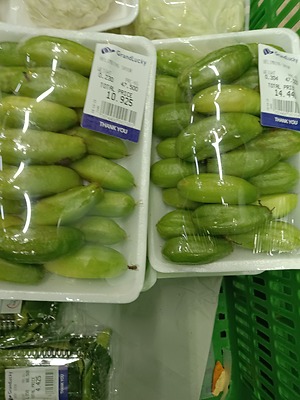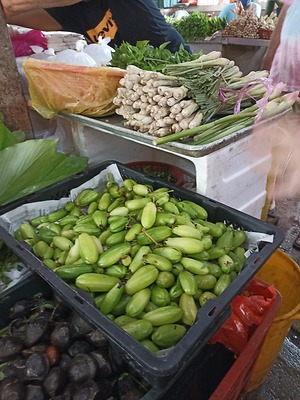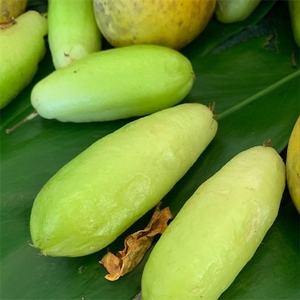

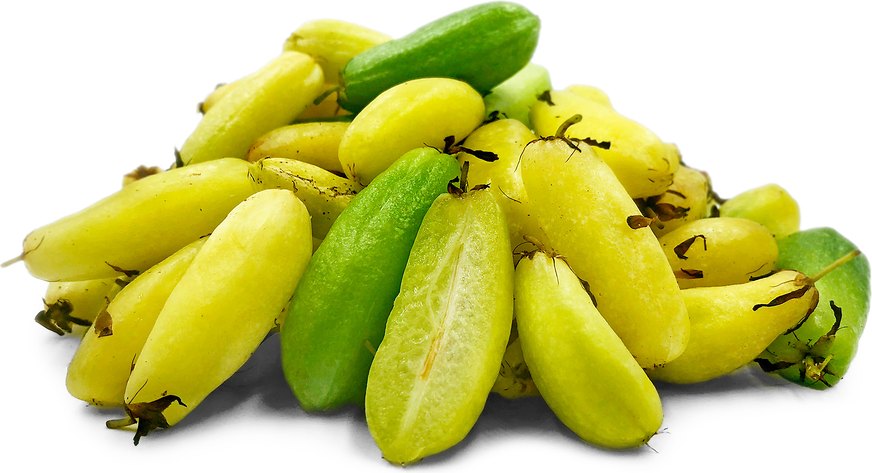
Bilimbi Fruit
Estimated Inventory, lb : 0
This item was last sold on : 05/06/24
Description/Taste
Bilimbi fruits are small, averaging 4 to 10 centimeters in length and 1 to 2 centimeters in diameter, and have an elongated, oblong, cylindrical, to ellipsoidal shape with blunt, slightly tapered ends. The fruit's exterior sometimes features five distinct sides created by shallow ribs, and the stem-end is capped with a thin, dark brown, and brittle star-shaped calyx. The fruit’s skin is thin, being easily damaged, bruised, or punctured, and has a smooth, glossy, taut, and waxy feel. The skin ripens from dark green to shades of light green, yellow-green, ivory, to white when ripe. Underneath the surface, the flesh is crisp, firm, aqueous, and pale green when young, lightening in color, and becoming softer and more jelly-like as it ages. When sliced in half, the fruits reveal a five-pointed star in the center of the flesh and contain 6 to 7 tiny, light brown seeds. Bilimbi fruits release a refreshing aroma and are edible raw or cooked. When raw, the fruits taste sour, acidic, tart, and tangy.
Seasons/Availability
Bilimbi fruits are available year-round in tropical climates.
Current Facts
Bilimbi, botanically classified as Averrhoa bilimbi, is a tropical species belonging to the Oxalidaceae family. The small fruits develop on evergreen trees reaching 10 to 15 meters in height and grow in hanging clusters directly from the trunk or dangling stems. Bilimbi fruits typically mature 50 to 60 days after flowering, and each tree can produce 45 to 50 kilograms of fruit per year. The fruits are carefully picked by hand in clusters or individually from the tree, and some ripe versions are also collected from the ground. Bilimbi is the Hindi name for the species, and the fruits are prevalent in India as medicinal and culinary ingredients. The fruits are also known by several descriptors worldwide, including Tree Cucumbers, Tree Sorrel, and Pickle Tree in English-speaking regions, Billing-Billing, Belimbing Buloh, Belimbing Asam, and B’Ling in Malaysia, Blimbing, Blimbing Wuluh, Balimbing, Belimbing Besu in Indonesia, Taling Pling or Kaling Pring in Thailand, Pias, Camias, and Kamias in the Philippines, and Khe Tay in Vietnam. Bilimbi is favored for its acidic, sour nature and is used for its refreshing, tart, and tangy nuances in a wide array of fresh and cooked culinary preparations. The fruits are also extensively used in natural medicines throughout Southeast Asia as an anti-inflammatory.
Nutritional Value
Bilimbi fruits are a source of vitamin C to strengthen the immune system, vitamin A to maintain healthy organ functioning, and potassium to balance fluid levels within the body. The fruits may also provide some calcium to protect bones and teeth, magnesium to control nerve functions, iron to develop the protein hemoglobin for oxygen transport through the bloodstream, and other nutrients, including zinc, manganese, copper, and phosphorus. The high tannin and terpene content in Bilimbi contributes anti-inflammatory properties to reduce swelling in the body and the fruits contain antioxidants to guard the cells against the damage caused by free radicals. Antioxidants are also sourced to improve skin complexion by mashing the fruits with honey and applying them topically on the skin. It is important to note that Bilimbi fruit contains oxalates, an organic acid naturally found in plants that may cause health issues if consumed in excess quantities. Bilimbi should be eaten in moderation or cooked to reduce oxalate content. In natural medicines, Bilimbi fruits, leaves, and flowers are used in concoctions, tinctures, and tea to soothe coughs and lessen fevers.
Applications
Bilimbi fruit has an acidic, sour, and tart flavor suited for fresh and cooked preparations. The fruits can be eaten raw but are typically dipped in salt, sugar, or other spices to improve the flavoring. Bilimbi can also be blended into various juices, made into a refreshing lemonade-like drink, or used to make syrups and vinegar. In addition to fresh preparations, Bilimbi fruit can be simmered into preserves, chutney, relishes, and pickles, cooked into sweet and sour jams, or incorporated into savory sauces. The fruit juice can also be combined with other stewed fruits to create a balanced flavor when the dish is overly sweet. In Indonesia, Bilimbi fruit is added to sambal, a type of fragrant chili paste, and is used as a condiment. The fruits are also salted, sun-dried, and ground into a spice. In India, Bilimbi is cooked into curries, soups, and dals. The fruits are also combined into fish dishes and give a sour flavor. Bilimbi fruits are often infused into seafood dishes to add brightness, and in the Philippines, the fruits are popularly added to sinigang, pinangat, or crunchy salads. Bilimbi fruit pairs well with seafood such as fish, shrimp, and crab, meats including pork, poultry, and beef, and spices such as garlic, turmeric, ginger, cumin, and coriander. Whole, unwashed Bilimbi fruit will keep for 4 to 5 days when stored in the refrigerator. The fruits can also be placed in the freezer for extended use.
Ethnic/Cultural Info
Bilimbi fruits are utilized as a cleaning agent for their acidic and oxalic acid-filled juice in Southeast Asia. The juice is used as a stain remover and helps bleach out fabric stains. Bilimbi fruit juice was also once incorporated into hand soaps and household cleaning supplies in the 19th-century Philippines. In Indonesia, Bilimbi juice was applied to traditional kris dagger blades to remove rust. These asymmetrical blades were handed down between generations, and there were different types for everyday and ceremonial purposes. Beyond cleaning, Bilimbi juice was occasionally used as a mordant for making orange dye to color silk fabrics, but minimal information is available about this past use.
Geography/History
Averrhoa bilimbi is native to tropical regions of Southeast Asia and was thought to have a possible center of origin in the Maluku Islands in Indonesia. The species has been growing wild since ancient times and was spread through human migration, trade, and natural causes. Over time, Bilimbi fruit trees were found across Southeast Asia and planted as home garden trees. In 1793, Bilimbi was notably recorded as being introduced to Jamaica through the Providence, a ship commanded by Captain William Bligh on his voyage to the New World. After its arrival in the New World, Bilimbi was distributed to the West Indies and was later planted in Central and South America. By the early 20th century, Bilimbi was prevalent in Puerto Rico and the Virgin Islands. It was also found in Hawaii, with possible introduction through Filipino immigrants. Bilimbi was carried to Queensland, Australia, in 1896, and the fruit became a specialty commercial cultivar. Today, Bilimbi thrives in warm, tropical climates in well-drained, sandy soil. The species has spread worldwide and is grown as a delicacy in Asia, Southeast Asia, Australia, Africa, and the Americas. When available, Bilimbi fruits are sold through local markets, specialty distributors, or foraged from wild trees as a fruit for homemade culinary recipes.
Recipe Ideas
Recipes that include Bilimbi Fruit. One
| Mouthwatering Food Recipes |
|
Bilimbi Parippu Curry |
| Recipes are Simple |
|
Shrimp Curry with Coconut and Bilimbi Fruit |



